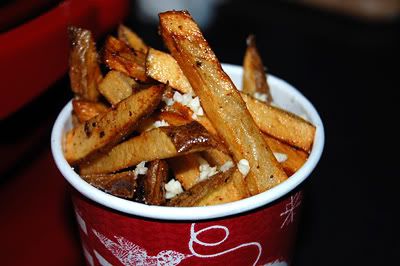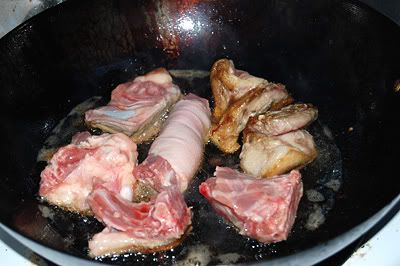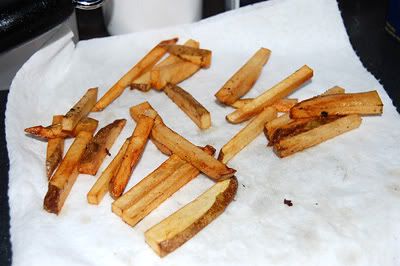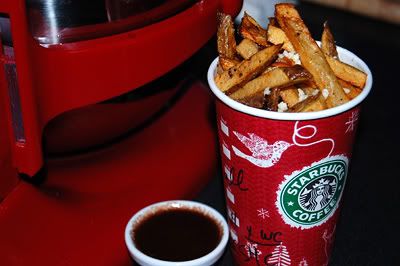
For me, a must with any Indian meal is raita. Every raita is as unique as the person making it. The seasonings, the vegetables, all vary from cook to cook. The one constant is plain yogurt. This can be any store-bought variety of plain yogurt, or you can make it yourself. Read further, and I will describe one way of making yogurt at home, and my method of preparing raita. If this is your first time making raita, you can use this recipe as a base and modify it to your own preferences.
I make only one or two cups at a time, because it's so easy and tastes best when freshly made. Generally I have a lot of leftovers when I make Indian food, and it's not a difficult task to make a fresh batch of raita every meal. I consume a lot of raita in one sitting -- probably more than most people. Though it's considered a condiment, to add a bit of freshness and tang or perhaps cut the heat of an overly spicy curry, I gobble it up as if it were a dish in its own right -- forking up an equal amount of raita and entree with every bite. Since it's mainly just yogurt and vegetables, it makes for a delicious and healthy breakfast or snack as well, but I just can't help but feel that I should be eating something with it.

I had several Indian dishes that I wanted to make in mind: palak paneer, aloo gobi, chicken makhani. And that, of course, meant that I would need to make raita. If I haven't made it apparent already, raita is an indispensable part of the experience of eating Indian food. Thanks to a mother who introduced me to the joys of spicy food early in life, I can take a lot of heat and it doesn't bother me. So my massive raita consumption has nothing to do with needing to cut the spiciness of any Indian dish. It's simply that I love the fresh, tangy contrast of the yogurt and vegetables with the heavily spiced, typically creamy entrees.
Here's my recipe for raita, with some notes below about each ingredient. It's such a simple recipe using simple ingredients that getting them right is key.
Raita
Ingredients
For the raita:
- 1 cup plain yogurt, well stirred to a light, creamy consistency
- 1 medium tomato, seeds removed, diced
- 1/4 English cucumber, julienned or diced
- 1/8 red onion, diced
- 1/4 tsp chat masala (recipe below or use store bought)
- salt to taste
- sugar to taste
- red chili powder or paprika, to garnish
For the chat masala (combine all below, then use 1/4 tsp of the mixture for the raita)
- 1 tablespoon cumin
- 1 tablespoon garam masala
- 1 tablespoon amchur
- 1 tablespoon black salt
- 1 teaspoon red chili pepper
- 1 pinch asafetida
- 1/4 teaspoon ground ginger
Method
- Mix all the raita ingredients together. Salt to taste. Add sugar if the yogurt you're using is particularly tart. Sprinkle red chili powder or paprika on top to garnish.
Notes on the ingredients:
Yogurt: Should be well stirred to a light, creamy consistency. Lowfat, nonfat, full fat, all work, they just have different levels of thickness, so use what you prefer. I really love Greek-style yogurt, which is especially creamy.

Tomatoes: The seeds/wet center should be removed. I've never tried using canned tomatoes, but this might be one dish where a substitution won't work. Definitely if you try it, you need to drain all the juice out or your raita will be too runny.

English cucumber: English cucumbers are better than regular cucumbers because they're normally wrapped in plastic, which prevents water loss, and thus they aren't waxed. That means they can be eaten without being peeled. They still have seeds in them (though sometimes they're called 'seedless') but the seeds are less prominent. Using regular cucumbers is fine, just make sure to remove the seeds and to peel the skin.

I like to julienne my cucumber with my mandolin (or you can grate it using the side of the grater with the larger holes) or dice it. A lot of people prefer their raita with larger pieces of vegetables, so it all depends on preference.
If you opt to julienne or grate your cucumber and you want a thicker raita, you will want to squeeze out as much water as you can from the cucumber. I don't need my raita to be super thick, so I leave the water -- and many nutrients -- in.
Onion: Any kind of onion will do; I like to use red because I love the color contrast.
Making Yogurt at Home
Now, as for making yogurt at home, it's a lot easier than you might think -- and certainly cheaper if making large quantities. The most difficult thing is regulating the temperature so that the good bacteria has the perfect environment to grow.

All you need is 4 cups (1 quart) of milk -- again, any kind will work, but what you choose will affect the final consistency, and 3 tablespoons of 'starter' plain yogurt, which can be a small container you've purchased from the grocery store or leftover from another batch of homemade yogurt. Heat the milk in the microwave or stovetop to boiling. Cool the milk to about 100°F (plus or minus 10°F is okay). Skim off the skin that's formed. Heat your oven to 180°F then turn it off. Whisk the yogurt in a large bowl until smooth and light. Add the warm milk and whisk until well incorporated. Transfer the mixture to a quart jar. Put the jar in the warmed oven for 4-5 hours (if you like a tarter yogurt, you can leave it for longer). It should be about 100°F at all times in there, so turn on the oven as needed, but make sure you don't get it too hot or you'll kill the necessary bacteria. At the end of that time, the consistency of the yogurt will be like that of a slightly watery pudding. It won't completely set until it's been chilled, so don't worry if it doesn't look exactly like yogurt yet. Put the container of yogurt in the refrigerator to complete the process.
Homemade yogurt will keep for about a week in the fridge.
When I need to buy starter yogurt I save the 3 tablespoons I need to make a batch of my own yogurt, then use the remainder to make a quick and yummy serving of raita!














































